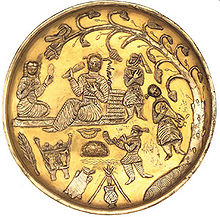| Musicians plate | |
|---|---|
 Sasanian silver dish, showing a ruler at outdoor banquet with attendants and musicians. | |
| Material | Silver, Gold |
| Size |
|
| Created | 7th century |
| Period/culture | Sasanid |
| Discovered | Tabaristan |
| Present location | British Museum, London |
| Identification | 1963,1210.3 |
| British Museum webpage for this plate. | |
Musicians plate ( Persian: بشقاب نوازندگان) is a partially gilded silver plate or dish found in Tabaristan. [1] It was probably made in the 7th or 8th century in modern Iran, then under the Sasanian Empire, and is now in the British Museum. It shows a ruler reclining luxuriously, as he picnics while his musicians play. [2] The plain background is gilded, while the figures and objects in low relief are left in silver. The musician on the far right is playing a stringed instrument which could possibly be an oud or barbat.
It was bequeathed to the museum by Sir Augustus Wollaston Franks in 1897. [3]
References
- ^ Mohammad Panh, Behnam. Ancient land (in Persian). Sabzan. ISBN 978-964-8249-34-7.
- ^ "Dish", British Museum webpage for this plate.
- ^ "Dish", British Museum webpage for this plate.